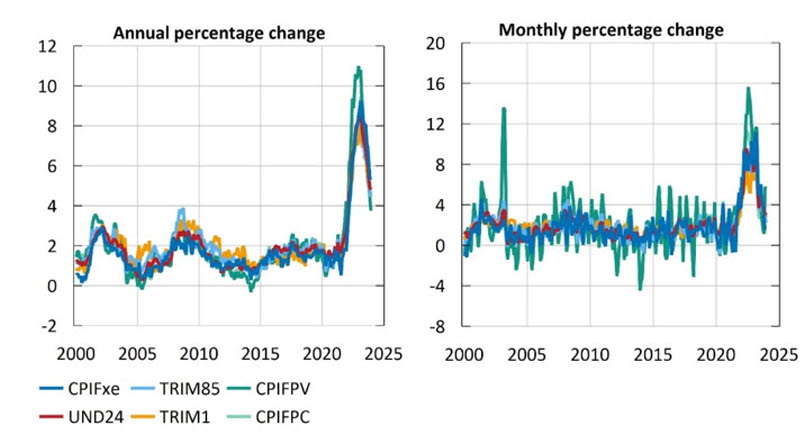Measures of core inflation
NR 3 2024, 21 February
Measures of core inflation
Published: 21 February 2024
In Sweden, inflation is usually measured as the annual percentage change in the CPIF. Measured inflation rates are often affected by temporary price changes, which are of no significance for the development of inflation in the longer term. Like other central banks, the Riksbank therefore calculates different measures of core inflation, to get a picture of how high the more persistent part of the measured inflation rate is.[4] See the article "Why measurements of core inflation?" in Monetary Policy Report October 2018 and J. Johansson, M. Löf, O. Sigrist and O. Tysklind, "Measures of core inflation in Sweden", Economic Commentaries No. 11, 2018.
Although many central banks use measures of core inflation in their communication, there is no clear definition of this concept and there are many different ways of calculating them. A common approach is to exclude certain predetermined components from CPIF inflation, namely those that are considered to reflect more temporary and short-term movements in the measured inflation rate than the other components do. The CPIF excluding energy is an example of such a measure. Another way is to use statistical methods to systematically exclude or lessen the significance of components in the CPIF whose prices fluctuate sharply. The Riksbank's TRIM85, UND24, CPIFPV and CPIFPC are examples of such measures. These measures are described in the appendix.[5] The measures of core inflation discussed and evaluated in this Economic Commentary are those that use statistical methods to reduce the significance of those goods and services whose prices have historically varied the most, or which exhibit the most extreme price changes in a given month.
Inflation is normally measured as the annual percentage change in a price index. To obtain a more up-to-date picture of how high inflationary pressures are, we can instead look at price changes calculated over shorter periods.[6] A challenge when analysing monthly rates, is that they vary more than annual percentage changes as they are often affected by seasonal factors, which can be difficult to exclude entirely using existing methods. In recent years, therefore, the Riksbank has increasingly analysed measures of seasonally adjusted price changes over periods shorter than one year (see Figure 1).[7] An implication of this is that the seasonal adjustment is re-estimated for the entire history each time new data are added and that the history of the measures changes for each new month of data added.
Figure 1. Measures of core inflation
Percentage changes

Note. The graphs show the annual percentage change on the left and the monthly percentage change of annualised seasonally adjusted data with a three-month moving average on the right.
Sources: Statistics Sweden and the Riksbank.
Economic Commentary
NR 3 2024, 21 February
Download PDF